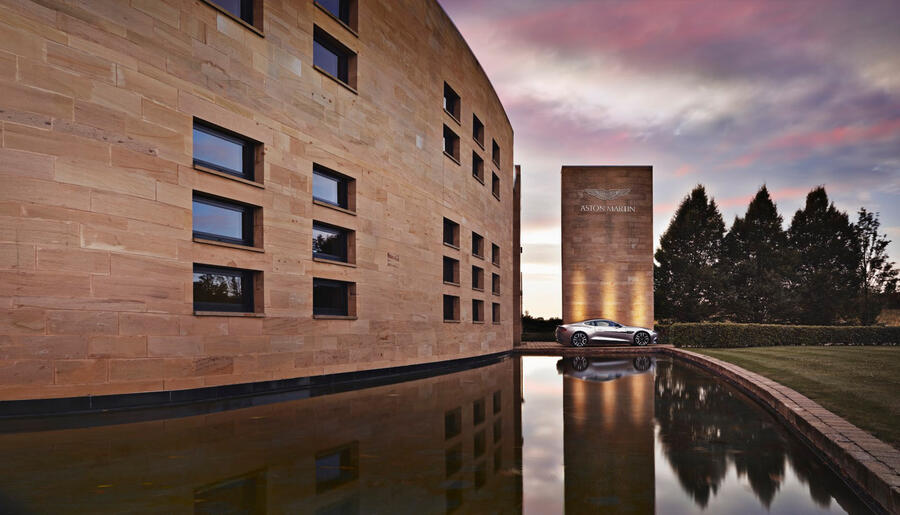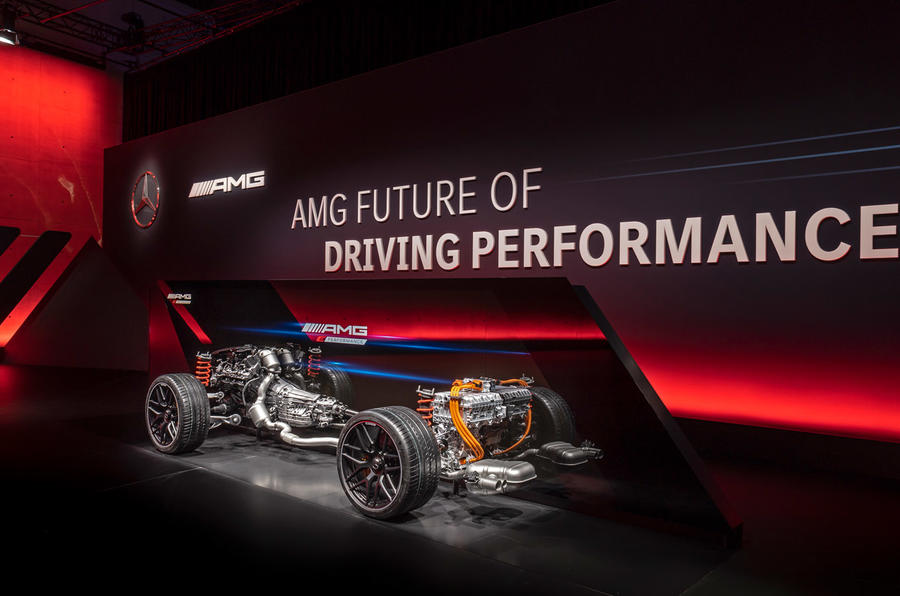
The new CEO has quietly been overhauling “a company in trouble” since taking over at Aston Martin. A year on, it’s ready to unleash a new generation of cars.
Tobias Moers may seem like the new boss at Aston Martin, but it’s more than a year since he was hired and 10 months since he first moved into the CEO’s office. The combined effects of the pandemic and Moers’ preference for delivering results rather than soundbites mean he has been pretty much unreachable – until now.
However, as soon as he starts talking about progress, you can see why he has been keeping a low profile. There has been much urgent stuff to get on with, and most of it under the eagle eye of the stock exchange (Aston’s share price is still 10% of its flotation level) and of his take-no-prisoners chairman, Lawrence Stroll, the Canadian fashion mogul who personally owns the Aston-badged Formula 1 team. Much better, under such circumstances, to underpromise and overdeliver.
Moers has carefully chosen the date of this meeting at Gaydon with me and editor Mark Tisshaw. In a couple of days, he explains, he will be able to give bullish details of Aston’s first-quarter trading. Everything is percolating. Surplus sports cars in the pipeline have been cleared, senior management is now peppered with competent people who Moers trusts, Gaydon’s production system has been heavily reorganised and a new model development plan is on the way to implementation.
Moers has chosen a ground-floor meeting room inside the Gaydon HQ for our chat, rather than the ritzier and more personal corner office once occupied by Andy Palmer and Ulrich T Bez before him. The casually dressed German, 55, cuts an austere and slightly reluctant figure; his manner makes it clear he prefers not to have visitors clocking how his desk and office are curated. Even the rather hurried way his matt-grey Vantage is parked in the CEO’s generous parking space outside indicates that he prefers work to window dressing.

We’ve both interviewed Moers in his previous gig as head of Daimler’s thriving AMG arm (he had spent his entire career there, rising through the ranks). We’re aware that he’s hearteningly passionate about great cars, but that he also takes time to warm up. So we start in an obvious place: has he been to Aston before, what did he expect to find and what was his early experience?
Refreshingly, he answers straightforwardly, neither referring directly to previous management nor sparing anyone’s blushes. He visited a couple of times years ago, he says. Nothing significant. When he arrived in August last year, he found “a company in trouble”. Immediate impressions were that it needed to be more efficient, in particular needing to be “sorted out” on the manufacturing side and requiring more engineering power. The bodyin-white manufacture (“the IP of the company”) was handled really well, he says, although he was puzzled about previous decisions to create a unique electrical architecture for the cars (“maybe they underestimated the challenge”). On the positive side, he drove all of Aston’s cars and decided they were okay (“they had everything; just needed to unleash a bit more”). In the first two months at Aston Martin, he devised an immediate action plan called Project Horizon, then took two more months to reorganise things and start improving efficiencies.
That entailed completing the selloff of cars in stock, moving Aston front-engined sports car production onto one line (in preparation for the forthcoming mid-engined Vanquish and Valhalla to occupy the other) and greatly reducing component stocks beside the active line (a big saving in working capital). He also closed a 90,000-square-foot site at nearby Wellesbourne previously earmarked for the Valkyrie hypercar, because that project could also move to Gaydon in time for first deliveries later this year.

He also ditched Aston’s plan for a unique new V6, because he felt it simply didn’t justify the expense. “What I found was a concept engine not yet capable of meeting Euro 7 standards and needing another huge investment,” he says. “I would prefer to put my money into things like an electrified front axle for the Valhalla, or batteries, or into extending our model portfolio.” So future internal combustion Astons will use mostly AMG power. Does this mean the firm under Moers will stray too close to AMG, if so many new-wave engines come from Affalterbach?
The new CEO says his board has considered this and they don’t believe there’s a problem. They’re great products, and in any case, the new powertrains will need many changes to suit mid-engined cars. Besides, it’s software that nowadays controls the behaviour of engines, not the oily bits, and one huge advantage of Aston’s recently enhanced Daimler link (the world’s oldest car company now owns 20%) is that it becomes a ‘white box’ customer with access to all the inner software secrets.
Previously, it was a ‘black box’ customer, needing to graft its own software onto untouchable components arriving from Germany, which is one reason why the DB11’s V12 has never had perfect lowend engine responses. That’s one foible that’s rapidly being improved, says Moers.
On model planning, Moers claims not even to have read former boss Palmer’s ‘seven models in seven years’ strategy, concentrating instead on writing his own. “We will do more than 10 new models between now and 2023,” he says. The new chain of command is classically organised: the CEO presents model plans to the board, who approve them or not. Stroll is “active on the marketing side”, which is where he has special expertise, but leaves car stuff to Moers.

The identity of the forthcoming 10-plus models isn’t entirely clear, but it’s likely Moers counts the first as the recently revealed Vantage F1 Edition, so named without Bernie Ecclestone-era costs because Stroll is part of F1’s inner sanctum. Then there are three versions of the V12 Valkyrie (road and track cars this year, drophead in 2022), two extra iterations of the DBX SUV (entry model soon, go-faster version in 2022), plus updates of the existing DB11, Vantage and DBS Superleggera. That’s nine cars, but Moers has already revealed that the latter front-engined trio will “broaden their ranges”. It’s not hard to imagine F1 editions of the DB11 and DBS waiting in the wings.
Looking beyond that, the refreshed trio will last another three or four years to about 2025, then they will be replaced and those replacements will be electrified. It’s not clear yet whether that means by battery electric or plug-in hybrid designs, but probably a mix of both.
What about Lagonda? As far as Moers is concerned, for the time being it’s a goner. “We have taken it aside to define it properly,” he explains. “Lagonda was a name used for everything – extra luxury, electrification, different body formats. The use of Lagonda as a pure-electric marque was just wrong. It dilutes the main brand.”
As our discussion proceeds, we’re frequently tongue-tied by the disparate names of Aston models that defy both logic and our powers of pronunciation. Naming is a thorny Aston subject that has been tackled by at least half a dozen previous bosses, but Moers refuses to join the debate. “It’s not on my priority list,” he says. “DB11 will be DB11. Don’t ask me if I like these names. Maybe there will be an opportunity to change them in future, but for now we keep them.”
Looking forward, Moers is surprisingly helpful about the size of the Aston he envisages. He’s targeting 10,000 cars per year once the mid-engined Vanquish and Valhalla models get to market and is confident about selling at decent margins. This hoped-for volume breaks down roughly into 4000 front-engined sports cars, 2000 mid-engined cars and 4000 DBX SUVs.

Aston’s management reckons to be turning profits by around 2025. After serial delays, production of the $4.03 million Valkyrie is about to begin, although Moers still hasn’t met the car’s original inspiration, Red Bull F1 designer Adrian Newey. It’s a bit more awkward now, because Red Bull and Aston are F1 rivals, although Moers says the two parties are working together “in a good way”.
The plan is to make 150 road-going Valkyries and 25 track-only editions, and Moers shows every sign that he will be pleased when the last of them has reached its owner. He has driven the car and likes it (“it’s exactly the car you should buy if you want an active F1 car for the road”), but he’s unforgiving about the many delays in a complex programme. “There have been a lot of excuses,” he says quietly.
When we ask if he would consider another F1-inspired car, there’s a long pause. “I’ve done it twice now,” he says, alluding to previous unspecified battles with Mercedes’ Project One hypercar programme. “I need a deep breath to think about that one…”
We’re running out of time. Aston bosses usually say the James Bond question is the first one they’re asked in interviews, but we’ve been talking for 45 minutes and not yet faced it. So will the 007 association continue? “It’s an important legacy,” Moers says carefully, “but it’s just one of many things that makes Aston Martin special.”
Then, when he perceives that we might feel this answer reveals a lack of enthusiasm, he warms up. “Yes, I think the 007 association will continue.” Does he actually like it? “Sure, it’s a cool story, and a piece of our history we should maintain. Others have tried to take it, but no one has managed to push Aston away.”
How is Aston performing?
According to commentators, Aston Martin Lagonda did considerably better than expected in the first quarter of the financial year just ended, notching sales worth $446 million – 55% of them DBX SUVs – against analysts’ earlier estimates of $366 million. Revenue increased more than 150%. “On both our short- and medium-term targets, we remain more confident every day,” Lawrence Stroll told Bloomberg, describing the latest result as “very indicative of what’s to come”. The AML share price, which plummeted rapidly from a 2018 issue level of $38 to less than $2, has nearly doubled in a year.
The truth about the AMG ‘walkout’

Tobias Moers is well aware of stories rife in Germany that his decision to change jobs began with a board meeting walkout after he was confronted by a need to change MercedesAMG’s multi-cylinder engines – the bellowing behemoths he had been engineering over a 26-year career – for electrified four-pot powertrains. He denies the stories flatly.
The push to change to electrified four-cylinder engines came from me,” he says. “There was no walkout. I wanted the plan because I believed in it. I took this job [at Aston Martin] because Lawrence Stroll reached out to me at the beginning of last year and I thought ‘yes, Aston Martin deserves to be better’. And there was a personal element, too. I had had 26 years with a big company: was there a chance for another challenge?”
Tobias Moers on…
The new Vantage F1 Edition: “It brings that car to its full potential. It has a similar output to the standard car, but it’s nearly 15 seconds faster around the Nordschleife. We did that by refining details, by using my own experience with transaxle cars and the experience of others within the company.”
Future Lagondas: “Aston aligning with F1 should make our image a bit sportier. I saw this happen with Mercedes. That should leave room for a more luxurious brand like Lagonda. I like this idea, but it’s not yet developed and isn’t a priority.”
Reorganising production lines at Gaydon: “If you’re making 12 to 15 cars a day and you have 400 in the process, it’s too many. We changed to one production line for our three front-engined cars, with 23 assembly stations instead of 70. Our quality is now much better.”
The hybrid era: “It’s an important step, even if it’s not going to last. Customers get access to electrification, keep their freedom, can have a high power output yet the fuel consumption falls. By 2030, 95% of our cars will be fully electrified or hybrid. The last 5% will be track-only; maybe that will be a new form of luxury.”
Building the brand: “We have a bit of time [before the arrival of the Vanquish and Valhalla] to build the brand. Aston stands for beauty, but maybe we lean too much on that. We’re a performance brand and a luxury brand as well. That gives us opportunities in the future, more than some Italian competitors.”
Making a great Aston Martin car: “For me, precision is very important. Precise steering, controlled body movement, less oscillation at the back. You need to be able to slide the car under perfect control, without being an F1 driver. Above all, you have to deliver what you promise – and we will.”
Using the F1 connection: “We’re taking the most we can from it. The main benefit is awareness: we have 80 million people engaging with our brands over a weekend. For us, it’s perfect. We have a full works team, but because it’s owned by Lawrence Stroll, our costs are lower than last year.”
The German view of Aston: “Everybody who knows Aston likes it, but we need to build our performance image the way we have with the Vantage F1 Edition. With a 7min 30sec lap of the Nordschleife, we’re now in the ballpark. It’s something we can do with the other cars as well.”
Steve Cropley



